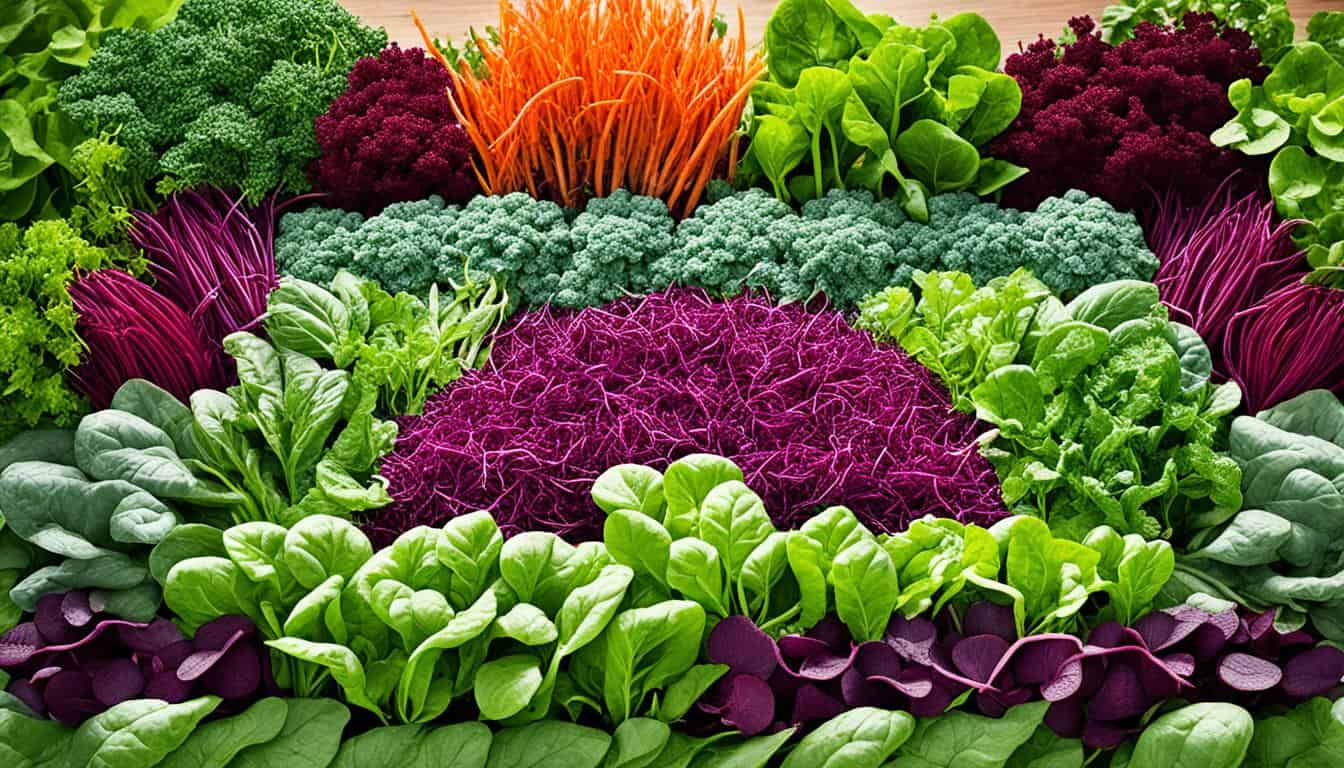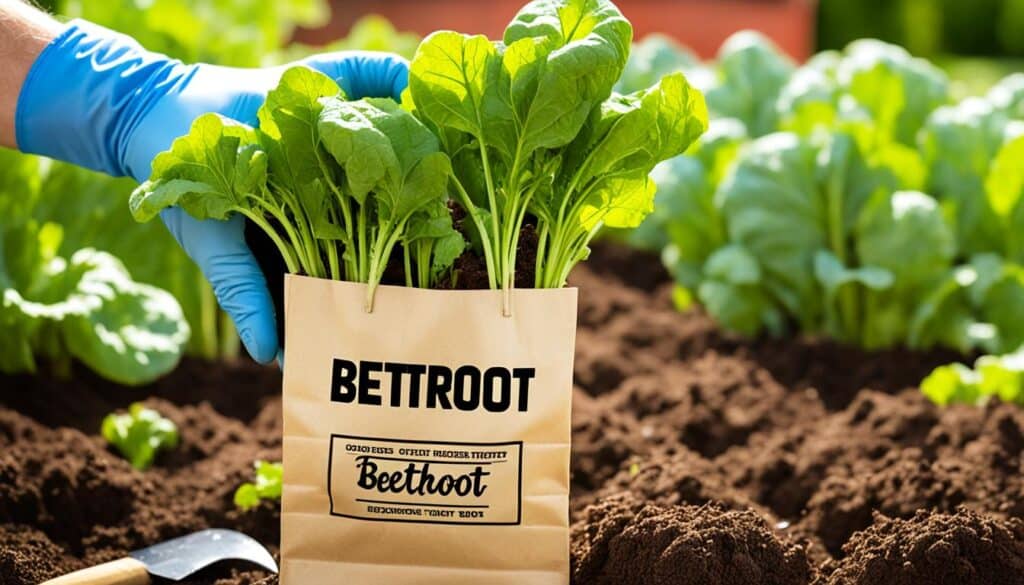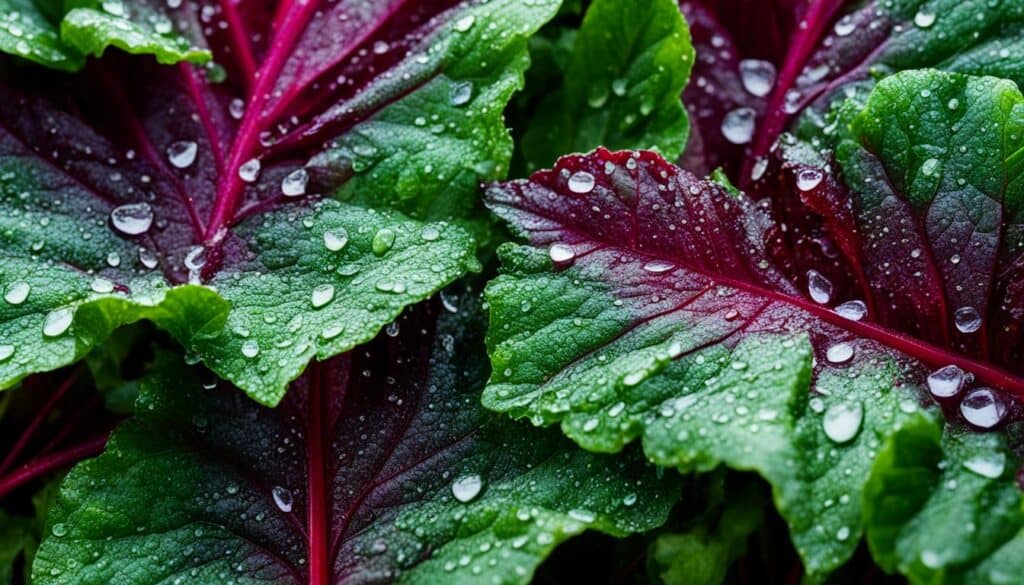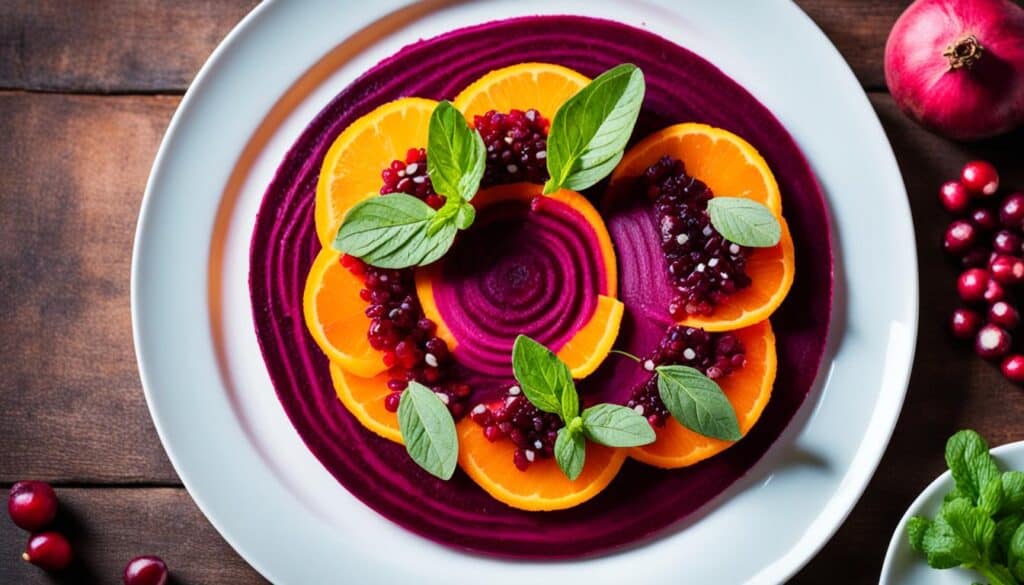Beetroot, with its rich colors and earthy flavor, is a popular vegetable that is not only delicious but also packed with essential nutrients. Whether you’re a seasoned gardener or just getting started, growing your own beetroot from seeds is a rewarding and satisfying experience.
In this article, I will provide you with expert tips and guidance on how to successfully cultivate lush beetroot seeds in your own garden. From sowing the seeds to harvesting and storing the beetroots, you’ll learn everything you need to know to grow a bountiful crop of this versatile vegetable.
Key Takeaways:
- Beetroot seeds can be easily grown at home, providing a consistent supply of nutritious beetroots.
- Follow expert tips and guidance to successfully cultivate lush beetroot seeds in your own garden.
- Learn how to sow the seeds, prepare the soil, thin and space the seedlings, and companion plant with beetroots.
- Discover the culinary uses of beet leaves and explore delicious recipes using beetroot.
- Get insider tips and tricks from gardening enthusiasts to enhance your beetroot gardening experience.
Sowing Beetroot Seeds
Growing beetroot from seeds is the best way to ensure a successful harvest. Unlike many other plants, beetroot seeds do not transplant well, so it’s best to sow them directly in your garden. Follow these simple steps to get started:
- Choose a sunny spot in your garden for your beetroot patch. Beetroot thrives in full sun, so make sure the chosen location receives at least 6-8 hours of sunlight daily.
- Prepare the soil by removing any weeds and loosening it with a garden fork or tiller. Beetroot prefers well-draining soil, so amend with compost or organic matter if needed.
- Soak the beetroot seeds overnight in water to help with germination. This step is optional but can improve the germination rate.
- Sow the seeds directly into the soil, either in rows or in clusters. Plant them at a depth of about 1/2 inch and space them 2-3 inches apart.
- Water the seeds thoroughly after sowing to ensure good soil contact. Keep the soil consistently moist but avoid overwatering, as this can cause the seeds to rot.
- Depending on your soil and climate conditions, you may want to cover the seeds with a light layer of mulch to conserve moisture and protect them from extreme temperatures.
Tips for Success
Here are some additional tips to help you succeed in sowing beetroot seeds:
- Choose organic beetroot seeds or heirloom varieties for a more natural and diverse garden.
- Consider buying beetroot seeds from a reputable supplier to ensure high-quality seeds and a wider selection of varieties.
- Use a beetroot seed packet for accurate spacing and planting instructions.
- Monitor the soil temperature before sowing. Beetroot seeds germinate best when the soil temperature is between 50-85°F (10-29°C).
- If you have limited garden space or poor soil conditions, consider growing beetroots in containers or raised beds.
Sowing beetroot seeds is an exciting first step in growing this vibrant and nutritious vegetable. With proper care and attention, you’ll soon be enjoying homegrown beetroots that are bursting with flavor.
| Variety | Description |
|---|---|
| Detroit Dark Red | A classic variety with deep red flesh and smooth skin. It’s known for its sweet flavor and excellent storage capabilities. |
| Bull’s Blood | This variety has striking dark purple foliage and a sweet, earthy flavor. The leaves are also edible and can be used in salads or sautéed. |
| Jupiter | With a round shape and vibrant red color, Jupiter is a popular choice for its tender texture and sweet taste. |
| Chiogga | Also known as candy stripe beet, Chiogga has beautiful pink and white concentric rings when sliced. It has a mild flavor and adds visual interest to dishes. |
Soil Preparation for Beetroot Seeds
Beetroot seeds require well-draining soil for optimal growth. To ensure your garden soil has good drainage, consider the following tips:
- If your soil is sandy or clay-based, it may benefit from the addition of compost. This will improve its texture and drainage capabilities, creating a more favorable environment for beetroot seeds.
- In areas with poor drainage, creating a mound or raised bed can help overcome this challenge. The elevated soil allows excess water to flow away more easily, preventing waterlogging and ensuring the beetroot seeds’ roots stay healthy.
- An alternative option for limited space or problematic soil is to grow beetroots in pots. This allows for better control over the soil quality and ensures proper drainage.
To illustrate the importance of soil preparation for beetroot seeds, take a look at the table below:
| Soil Type | Preparation | Advantages |
|---|---|---|
| Sandy soil | Add compost | Improves water retention |
| Clay soil | Add compost | Enhances drainage |
| Poor drainage | Create a mound or raised bed | Prevents waterlogging |
| Limited space or soil issues | Grow in pots | Greater control over soil quality and drainage |
By preparing the soil appropriately, you can provide the ideal growing conditions for your beetroot seeds, ensuring they thrive and produce high-quality beetroots.
Thinning and Spacing Beetroot Seedlings
When growing beetroot from seeds, it’s important to thin out the seedlings to promote healthy growth and ensure round beetroots. Thinly spaced seedlings allow each plant to receive the necessary nutrients and space to develop fully. The larger the spacing between seedlings, the larger the beetroots will grow, providing you with a bountiful harvest.
To thin out the seedlings, gently pull out the weaker or excess plants, leaving behind only the strongest ones. This allows the remaining seedlings to have ample space to grow and encourages the development of robust, well-formed beetroots. Thinning is typically done when the seedlings are around 2-3 inches tall.
If desired, you can transplant the thinned-out seedlings to other areas of your garden or give them to fellow gardening enthusiasts. This not only prevents waste but also provides an opportunity to share the joy of growing beetroots.
Remember to be gentle when thinning and transplanting seedlings to avoid damaging their delicate roots. Handle the seedlings with care, ensuring they remain intact and undisturbed.
Thinning and spacing beetroot seedlings are essential steps in the growing process, as they contribute to the overall health and quality of your harvest. By giving your beetroot plants enough room to thrive, you’ll ensure that they produce robust and flavorful beetroots that you can enjoy in various culinary creations.
Companion Planting with Beetroot
Beetroot is not only a fantastic standalone crop, but it also thrives as a companion plant in your garden. By planting beetroot alongside long-term crops like tomatoes, beans, and cucumbers, you can maximize your garden space and enjoy a staggered harvest.
When selecting companion plants for beetroot, it’s important to choose varieties with spreading roots. This helps prevent competition for nutrients and ensures that each plant can grow to its full potential. Pairing beetroot with compatible plants can create a symbiotic environment that benefits all your crops.
“Companion planting with beetroot has been a game-changer in my garden. I’ve found that my tomatoes grow healthier and have bigger yields when planted alongside beetroot. Plus, the combination adds a beautiful mix of colors to my garden beds!” – Jane, experienced gardener
Companion Planting Chart
| Companion Plant | Benefits |
|---|---|
| Tomatoes | Beetroot’s deep roots help improve soil structure and moisture retention for tomatoes. Tomatoes provide shade to beetroot, preventing the soil from drying out quickly. |
| Beans | The nitrogen-fixing ability of beans benefits beetroot by enriching the soil with nitrogen, an essential nutrient for healthy growth. |
| Cucumbers | Beetroot acts as a living mulch, providing shade and conserving moisture for cucumber plants. Cucumbers provide vertical support for beetroot. |
Companion planting with beetroot is a win-win strategy for any garden. Not only does it create a visually appealing and diverse garden space, but it also promotes healthier plants and yields. Embrace the potential of companion planting and enjoy the benefits it brings to your beetroot and other crops.
Watering and Fertilizing Beetroot
Proper watering and fertilization are essential for the healthy growth of beetroot plants. Here are some tips to help you keep your beetroot plants thriving:
Watering:
Beetroot plants prefer moist soil, but it’s important not to overwater them. Keep the soil barely moist, making sure it doesn’t become waterlogged. Overwatering can lead to root rot and other plant diseases. Monitor the moisture level regularly and adjust watering accordingly.
Fertilizing:
Beetroot is generally a low-maintenance crop that doesn’t require heavy fertilization. However, a monthly biological feed can provide some beneficial nutrients to support healthy growth. Organic fertilizers, such as compost or well-rotted manure, are excellent choices for nourishing beetroot plants. Apply the fertilizer according to the manufacturer’s instructions, usually by spreading it evenly around the base of the plants.
In addition to fertilization, incorporating organic matter into the soil before planting can provide a nutrient-rich environment for beetroot seeds to grow and thrive.
Remember to always follow the instructions provided on the fertilizer packaging and avoid excessive use, as it can negatively impact the quality and taste of your beetroots.
| Watering and Fertilizing Beetroot Tips |
|---|
| Keep the soil barely moist and avoid overwatering to prevent root rot. |
| Use organic fertilizers like compost or well-rotted manure for monthly feeding. |
| Incorporate organic matter into the soil before planting for optimal nutrient availability. |
Harvesting and Storing Beetroot
Once your beetroot seeds have grown into vibrant plants, it’s time to harvest and store your precious yield. Harvesting beetroots at the right time ensures maximum flavor and freshness. Follow these simple steps to enjoy the taste of homegrown beetroots:
- Wait for your beetroots to reach the size of a billiard ball. This is the optimum size for harvesting, as beetroots can become woody if left to grow too large.
- Gently grasp the stem of the beetroot plant and pull it out of the ground. The entire plant should come out without breaking.
- Give the beetroots a gentle shake to remove any excess soil clinging to the roots.
- Find a cool and dark place to store your freshly harvested beetroots. A root cellar or a cool basement works well. Avoid storing beetroots near fruits or vegetables that produce ethylene gas, as this can cause them to deteriorate more quickly.
Now that you have harvested and stored your beetroots, it’s time to use them in delicious recipes and enjoy their earthy sweetness. Remember, fresh beetroots are best used immediately to fully savor their flavor and nutritional value.
| Guide to Harvesting and Storing Beetroot | |
|---|---|
| Step 1 | Wait for beetroots to reach the size of a billiard ball |
| Step 2 | Gently pull the entire plant out of the ground by the stem |
| Step 3 | Shake off excess soil from the beetroots |
| Step 4 | Store beetroots in a cool, dark place to maintain freshness |
Varieties of Beetroot
When it comes to beetroot, there is a wide range of varieties to choose from. Each one offers its own unique flavor and color, adding diversity to your garden and culinary creations. Whether you’re a fan of the traditional red beet or looking for something a bit more exotic, there’s a beetroot variety that will suit your tastes.
Here are some popular beetroot seed varieties:
- Detroit Dark Red: This classic red beet is known for its sweet flavor and tender texture. It’s a versatile variety that can be enjoyed raw, roasted, or pickled.
- Bull’s Blood: If you’re looking for a beet with stunning color, Bull’s Blood is the one for you. With its deep burgundy foliage and vibrant red roots, it’s as beautiful as it is delicious.
- Jupiter: Jupiter beets are prized for their smooth texture and sweet flavor. They are quick to mature, making them a great choice for those who can’t wait to enjoy their homegrown beets.
- Chiogga: This Italian heirloom beet features striking pink and white rings when sliced, adding a pop of color to any dish. Its tender and sweet flesh makes it a favorite among chefs.
These are just a few examples of the many beetroot seed varieties available. Experiment with different options to find the ones you love the most. You can find a wide selection of high-quality beetroot seeds from reputable suppliers.
Culinary Uses for Beet Leaves
Did you know that beet leaves are not only edible but also delicious? That’s right! Don’t let those beautiful beet greens go to waste. They have a similar taste to spinach and can be used in various culinary creations. Here are a few ways you can enjoy the nutritious and flavorful beet leaves:
- Sautéed Beet Leaves: Heat a little olive oil in a pan, add some minced garlic, and gently cook the beet leaves until they wilt. Season with salt, pepper, and a squeeze of lemon juice for a zesty side dish.
- Beet Leaf Salad: Toss the tender beet leaves with your favorite salad greens, cherry tomatoes, and a tangy vinaigrette dressing. The vibrant colors and earthy flavors will make this salad a crowd-pleaser.
- Beet Leaf Wraps: Use large beet leaves as a substitute for tortillas or lettuce wraps. Fill them with your choice of protein, vegetables, and sauces for a unique and healthy twist on traditional wraps.
- Beet Leaf Pesto: Blend beet leaves, garlic, Parmesan cheese, toasted pine nuts, and olive oil to create a vibrant and flavorful pesto. Use it as a spread on sandwiches, a sauce for pasta, or a dip for fresh veggies.
Before using beet leaves in your dishes, ensure that they are small and free from any insect damage. This way, you’ll enjoy the best flavor and texture in your culinary creations.
Now that you know how versatile beet leaves can be, don’t let them go to waste. Incorporate these nutritious greens into your meals and discover a whole new world of flavors.
Recipes Using Beetroot
When it comes to delicious recipes, beetroot offers a versatile and vibrant ingredient that can be used in various dishes. Whether you enjoy roasted vegetables, refreshing salads, or even probiotic drinks, beetroot can add a unique flavor and color to your meals. Explore the following recipes to discover new and exciting ways to enjoy this nutritious root vegetable.
1. Roasted Beetroot
Roasting beetroot brings out its natural sweetness and intensifies its flavors. It’s a simple yet satisfying dish that can be enjoyed as a side or incorporated into other recipes.
“Roasting beetroots in the oven enhances their natural sweetness, resulting in delicious caramelized flavors. Simply drizzle peeled and sliced beetroots with olive oil, sprinkle with salt and pepper, and roast them in a preheated oven at 400°F (200°C) for about 30 minutes, or until tender. Enjoy the roasted beets as a nutritious and tasty side dish!”
2. Beetroot Salad
A beetroot salad is a refreshing and colorful addition to any meal. It combines the earthy sweetness of beets with contrasting flavors and textures to create a delightful dish.
“For a simple beetroot salad, thinly slice cooked beets and arrange them on a bed of mixed greens. Sprinkle with crumbled feta cheese, toasted walnuts, and a drizzle of balsamic vinaigrette. It’s a perfect balance of flavors and textures, making it a great option for a light lunch or dinner!”
3. Beet Kvass
If you’re looking for a unique and gut-friendly beverage, beet kvass is worth a try. This fermented drink is not only delicious but also rich in probiotics, which can promote a healthy digestive system.
“To make beet kvass, chop one medium-sized beet into small pieces, and place them in a clean glass jar. Add filtered water, leaving about an inch of headspace. Stir in a teaspoon of sea salt and cover the jar tightly. Let it ferment at room temperature for about 3-7 days, depending on your desired flavor. Once ready, strain the liquid and refrigerate. Beet kvass can be enjoyed on its own or used as a base for various cocktails and mocktails!”
Remember, these are just a few examples of the many delicious recipes you can create using beetroot. Get creative and experiment with different flavor combinations to find your own favorite beetroot dishes. Enjoy the versatility and nutritional benefits of this vibrant root vegetable!
| Recipe | Description |
|---|---|
| Roasted Beetroot | Caramelized roasted beets with intensified flavors |
| Beetroot Salad | Refreshing salad with mixed greens, feta cheese, and walnuts |
| Beet Kvass | Fermented probiotic drink made from beets |
Tips and Tricks from Gardening Enthusiasts
Gardening enthusiasts have shared their tips and tricks for growing and using beetroot. These little-known secrets can help you maximize your beetroot harvest and elevate your culinary experience. Explore these suggestions to enhance your beetroot gardening journey:
- Use a muffin tin for spacing beet seeds: Fill the cups of a muffin tin with soil and sow a beet seed in each cup. This method ensures proper spacing between the seeds, allowing the beetroots to grow with ample room for development.
- Roast beets for easy peeling: Before cooking or using beets in recipes, try roasting them. Simply wrap the beetroot in foil and roast in the oven until tender. The skin will easily peel off, making preparation a breeze.
- Create delicious beet leaf bruschetta: Don’t discard those nutritious beet leaves! Sauté the leaves in olive oil with garlic and seasonings, then spread them on toasted bread for a unique twist on classic bruschetta.
These valuable tips and tricks from experienced gardeners will take your beetroot cultivation and enjoyment to the next level.
A little-known secret: Roasting beets brings out their natural sweetness and enhances their flavor.
Remember, gardening is a journey of discovery, and each individual may have their own unique approaches to growing and using beetroot. Don’t be afraid to experiment and find what works best for you.
Benefits of Beetroot Seeds
| Benefits | Organic Beetroot Seeds | Non-Organic Beetroot Seeds |
|---|---|---|
| Natural and chemical-free | ✓ | ✗ |
| Healthier for you and the environment | ✓ | ✗ |
| Supports sustainable agriculture | ✓ | ✗ |
| Guaranteed high quality and germination rate | ✓ | ✓ |
| Free from genetically modified organisms (GMOs) | ✓ | ✗ |
Choosing organic beetroot seeds not only benefits your health and the environment but also supports sustainable agriculture practices. Make an informed decision when purchasing beetroot seeds, and opt for high-quality organic varieties whenever possible.
Conclusion
Growing lush beetroot seeds at home is an incredibly rewarding and enjoyable experience. By following these tips, you can cultivate vibrant, healthy beetroots right in your own garden. Whether you prefer the traditional red beets, golden beets, or the beautiful purple varieties, there is a beetroot seed out there that suits your taste and preferences.
Experimenting with different varieties allows you to experience the versatility and deliciousness of beetroot in various culinary creations. From roasted beetroot and beetroot salad to the tangy goodness of beet kvass, there are countless ways to incorporate this nutritious vegetable into your meals.
So why wait? Stock up on organic beetroot seeds and embark on your beetroot gardening journey today. Whether you’re a seasoned green thumb or just starting out, growing your own beetroots is a satisfying and sustainable way to enjoy this versatile vegetable. Buy the best beetroot seeds and get ready to savor the earthy sweetness of homegrown beetroots!










Leave a Reply